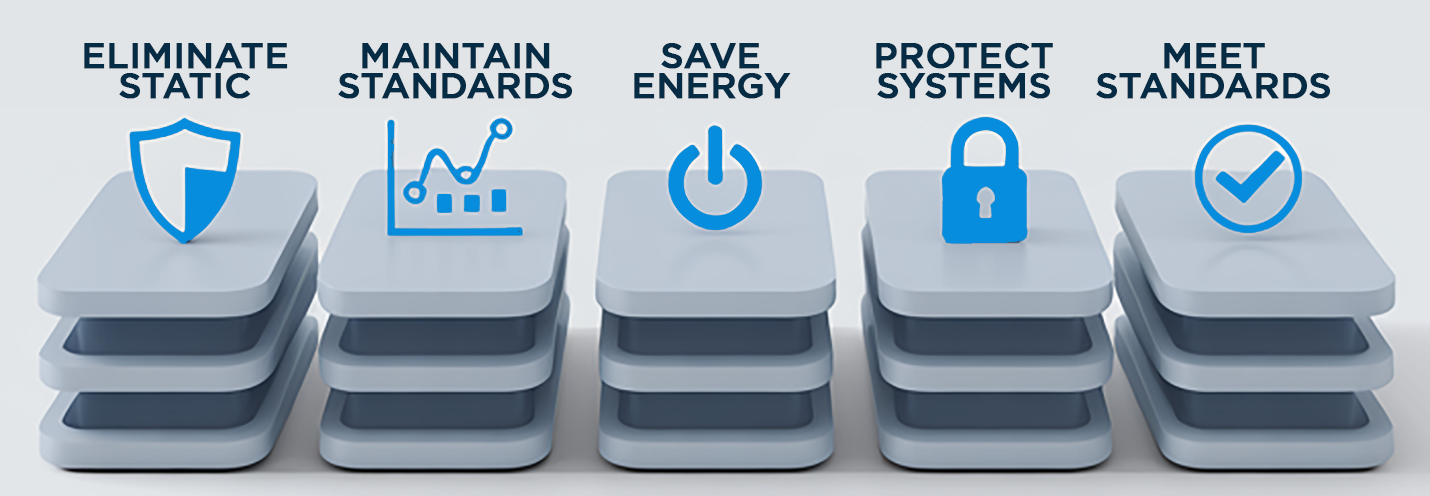The Invisible Risks Lurking on Your Production Line
Your lines run at thousands of boards an hour. Your AOI systems catch the slightest solder misalignment. Your team has invested in the best pick-and-place, reflow, and inspection tech money can buy.
But there’s one variable most facilities still underestimate — the air itself.
Tiny swings in humidity. Electrostatic charges invisible to the naked eye. Microscopic dust and fibers drifting through your clean zones. Any one of these can quietly push your defect rates up, stress your sensitive components, or cause latent failures that only show up in the field — long after your boards ship.
Electronics manufacturing humidity control isn’t just about keeping operators comfortable. It’s a critical safeguard for product quality, yield consistency, and ultimately your reputation.
Let’s break down why — and how to solve it without chemicals, heavy maintenance, or disruptive overhauls.
1. Eliminate Static and Protect Your Most Sensitive Assets
Every electronics plant knows about ESD. Yet many treat it like an afterthought — using grounding straps, floor mats, and occasional audits. But static doesn’t stop at the wrist strap. It builds up invisibly in the air itself.
- Low humidity = high static risk.
Dry environments allow charges to accumulate on surfaces, operators, and even the air itself. When discharged, they can destroy sensitive ICs, corrupt signals, or cause tiny hairline damage that leads to latent failures. - Static attracts dust and fibers.
Particles cling to charged surfaces, ending up in solder joints or on optics where they cause intermittent failures or calibration drift
Smart Fog tackles this at the air level.
By maintaining humidity tightly within ±2% of your target (typically 45–55% RH) and filling the environment with negative air ions, it neutralizes static across the entire space — not just on floors or benches.
Action takeaway:
Fewer blown chips, fewer mystery failures, and higher first-pass yield rates — all from controlling the air.
2. Maintain Cleanroom Standards Without Overloading Filters
You probably already have ISO 7 or ISO 8 cleanroom protocols in place, with multi-stage HEPA filtration. But those systems only clean the air that passes through them. Meanwhile, particles from packaging, operator garments, and even machine movement swirl through your production zones.
- Negative air ions generated by Smart Fog bond to microscopic particles (down to <0.1 micron), making them heavy enough to settle harmlessly out of the air.
- This reduces the overall particle count in your room — not just inside ducts — meaning your filters work less aggressively and last longer.
Action takeaway:
Cleaner air protects optics, lasers, sensors, and fine solder connections, reducing scrap and costly rework.
3. Stop Overworking Your HVAC and Save on Energy
Traditional HVAC setups try to control humidity by brute force: overcooling air to condense out moisture, then reheating it to process temperatures. This burns massive amounts of energy.
It also leads to broad RH swings. As systems cycle on and off, humidity may fluctuate by ±5–8%, well outside optimal ranges for electronics assembly.
- Smart Fog directly manages humidity in the room.
Ultra-fine dry fog droplets evaporate instantly, stabilizing RH without burdening your HVAC. The result: tighter control, less load on compressors, and significant energy savings.
Action takeaway:
Lower electricity costs, reduced HVAC maintenance, and more predictable environmental stability across all shifts.
4. Protect Optics, Lasers, and Sensor Systems from Dust and Static
In electronics manufacturing, it’s not just about the boards. Optical inspection systems, laser cutters, metrology gear — all rely on pristine surfaces and stable calibration.
- Static and airborne dust reduce lens clarity and can interfere with precise light paths.
- Even minor contamination can throw off automated measurements, causing good boards to fail QA or bad boards to pass unnoticed.
By controlling static through humidity and ionisation, and actively removing particles from the air itself, Smart Fog preserves the integrity of your most sensitive tools.
Action takeaway:
Longer intervals between recalibrations, fewer false positives in AOI/AXI, and higher throughput without quality compromise.
5. Meet Compliance Standards with Zero Chemical or Ozone Risk
Many electronics environments use ion bars or plasma systems to help reduce static. But these often create ozone or require chemical inputs, raising safety and compliance concerns.
- Smart Fog systems are UL 2998 certified for zero ozone emissions — safe for operators and compliant with strictest global air quality standards.
- They use only de-ionised water and compressed air, adding nothing harmful to your process or final product.
Action takeaway:
Keep auditors happy, avoid unexpected OSHA flags, and protect your operators’ long-term respiratory health.
FAQs: What Electronics Facilities Ask First
Q. Will Smart Fog cause condensation on my boards or equipment?
No. Droplets are under 4.2 microns and evaporate before reaching surfaces. Your process stays dry — only the air changes.
Q. Can it integrate into my existing environmental control systems?
Yes. It ties into your BMS for live RH and ion monitoring, with dashboard oversight.
Q. Is this just for cleanrooms?
Not at all. It works equally well in general electronics assembly areas where static and particles still cause major quality issues.
Q. How hard is it to maintain?
It’s virtually maintenance-free: no chemicals, no filters, no regular cleanouts. Annual inspections keep it dialed in.
Conclusion: Your Air is the Last Uncontrolled Variable on the Line
You’ve invested in SMT precision, laser calibration, ERP traceability. But without stable humidity and static-free, clean air, you’re still exposed to avoidable risk.
Smart Fog gives electronics manufacturers:
- Ultra-tight humidity control that stops static before it starts
- Active airborne particle reduction to protect boards and optics
- Lower HVAC loads that cut energy bills and extend equipment life
- Zero-chemical, zero-ozone operation for full regulatory peace of mind





